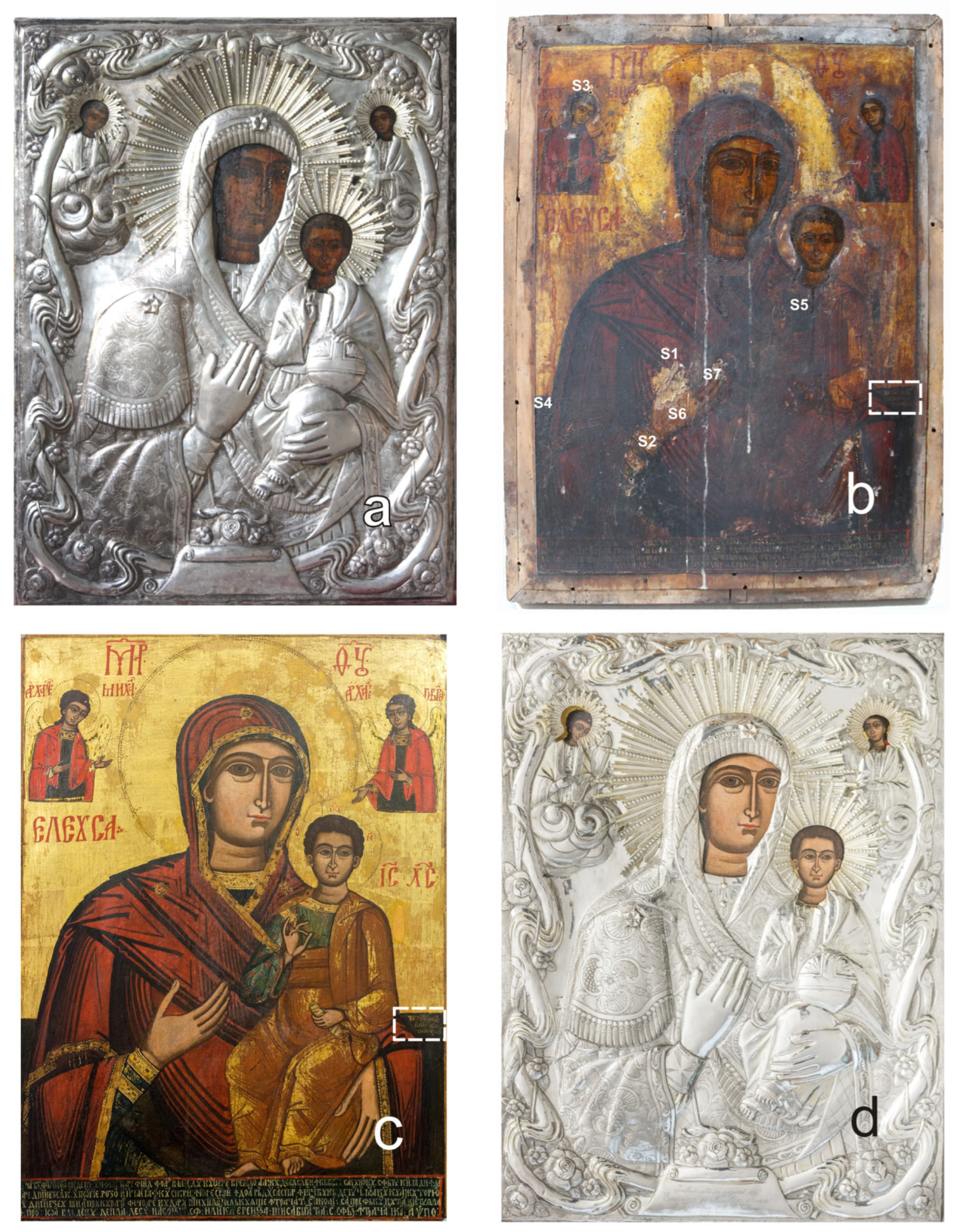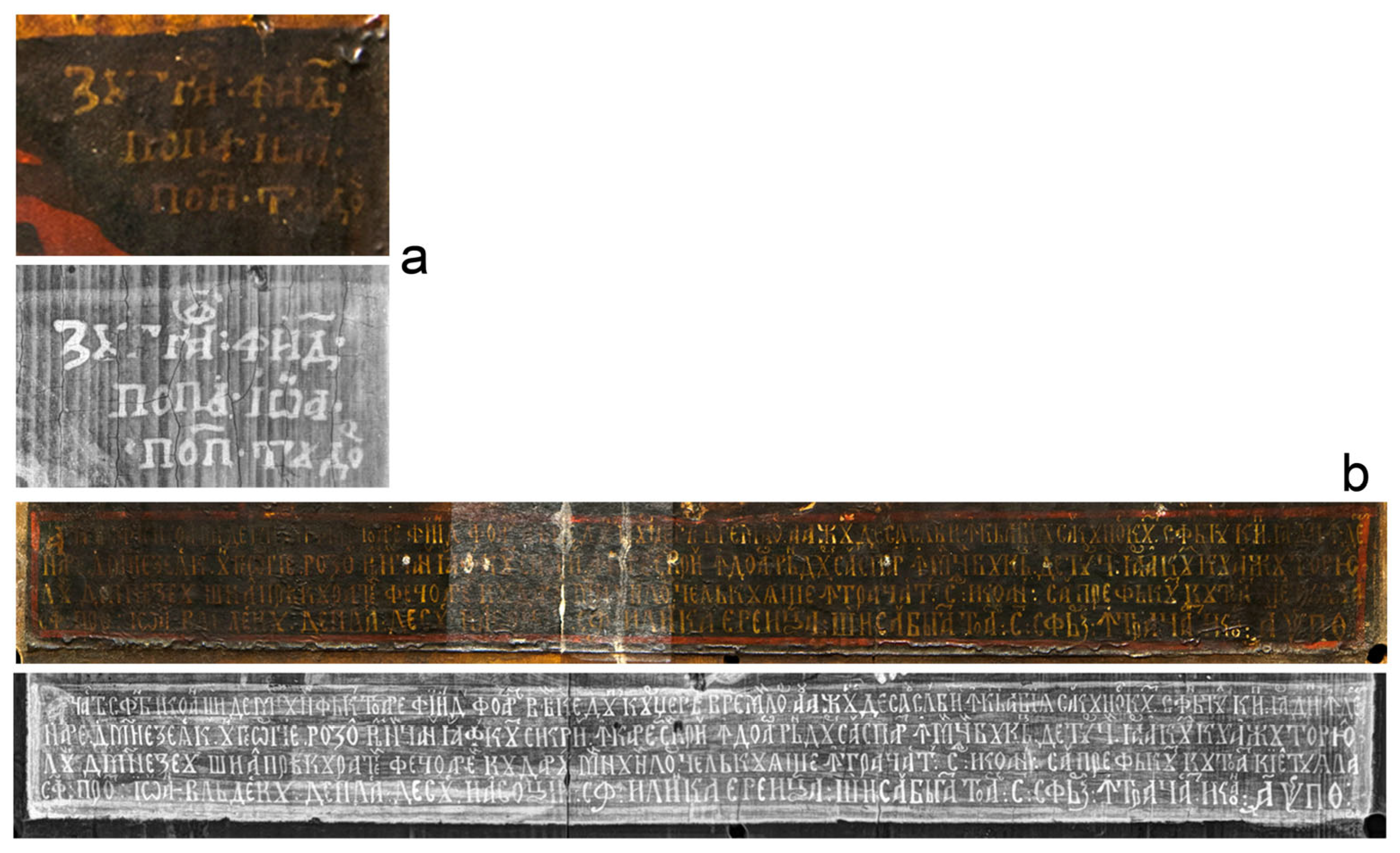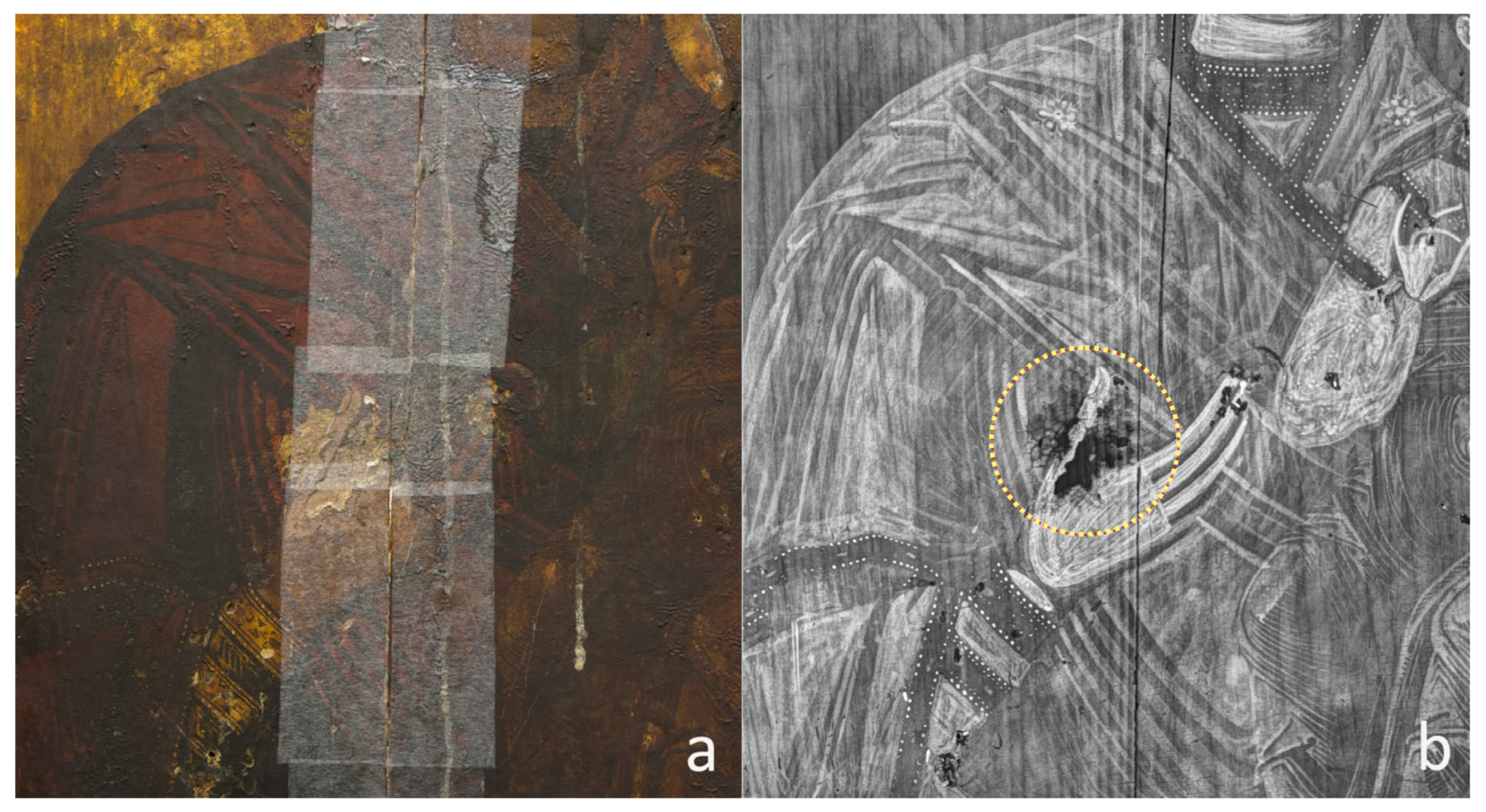A Multi-Analytical Study of a 17th-Century Wallachian Icon Depicting the “Mother of God with Child”
Abstract
:1. Introduction
2. Materials and Methods
2.1. The Icon
Această sfântă icoană și de minuni făcătoare fiind foarte veche după curgerea vremilor a ajuns de s-au slăbit încât nu s-au cunoscut sfântul chip. Si din îndem // nare d(u)mnezeiască, un Gheorghe Rozol Rămnicean i-au făcut sicriu; în care scriu în doao rânduri s-au spart în mici bucăți de turci. Iar acum, cu ajutoriul // lui D(u)mnezeu și al Preacuratei Fecioare, cu dar(ul) minunilor ce lăcuiaște într-această sf icoană s-au prefăcut cu toată chieltuiala // sf<inţitului> Preot Ioan Vlădescu de plas(a) de sus; i ar soția Sf<inţiei Sale este> Ilinca Ereița și s-au băgat toa(te) 200 sfanţi într-această ic(oană) 1789.
This holy icon and of working wonders being very old after the ages they’ve become weak so they did not know the holy face // And from the exhortation of God, a Gheorghe Rozol Rămnicean made him a casket that casket twice were broken into small pieces by Turks. And now, with the help of God and the Blessed Virgin, with the gift of miracles that dwells in this holy icon (the icon) was repaired with all the spending // of the holy priest Ioan Vladescu from the upper parish; and the wife of his Holiness is Ilinca Ereita, and all 200 schvantz have been put into this holy icon 1789.
2.2. High-Resolution Digital Radiography
2.3. Spectral Imaging—From UV Fluorescence to SWIR Hyperspectral Imaging
2.4. X-ray Fluorescence
2.5. Fourier Transform Infrared Spectroscopy
3. Results and Discussion
3.1. Imaging Documentation
3.2. Painting Materials
3.2.1. Ground Layer
3.2.2. Pigmenting Layers
4. Conclusions
Author Contributions
Funding
Data Availability Statement
Acknowledgments
Conflicts of Interest
References
- Samoilescu, D.C.; Duliu, O.G.; Manea, M.M.; Stan, D.; Constantinescu, B. A comparative study of two icons representing the “Coronation of the Virgin by the Holy Trinity”: Wallachia, 18th century and Transylvania, 19th century. J. Cult. Herit. 2017, 27, 175–180. [Google Scholar] [CrossRef]
- Theodorescu, R. Civilizația Românilor între Medieval și Modern. Orizontul Imaginii (1550–1800); Editura Meridiane: Bucharest, Romania, 1987; Volume 2. [Google Scholar]
- Mihalcu, M. Valori Medievale Românești; Editura Sport-Turism: Bucharest, Romania, 1984. [Google Scholar]
- Ene, I. Icoane Brâncovenești și Postbrâncovenești din Județul Vâlcea (1680–1730); Editura Offsetcolor: Râmnicu Vâlcea, Romania, 2011. [Google Scholar]
- Ștefănescu, I.D. Iconografia Artei Bizantine și a Picturii Feudale Românești; Editura Meridiane: Bucharest, Romania, 1973. [Google Scholar]
- Săndulescu-Verna, C. Materiale și Tehnica Picturii; Editura Marineasa: Timișoara, Romania, 2000. [Google Scholar]
- Stoichiță, V.I. Studiu introductiv și antologie de ilustrații. In Carte de Pictură; Dionisie din Furna, Editura Meridiane: Bucharest, Romania, 1979. [Google Scholar]
- Efremov, A. Icoane Românești; Meridiane Publishing: Bucharest, Romania, 2002. [Google Scholar]
- Mândru, D.E. Moștenirea Brâncovenească; Centrul Cultural Palatele Brâncovenești: Mogoșoaia, Romania, 2008. [Google Scholar]
- Voinescu, T. Radu Zugravu; Editura Meridiane: Bucharest, Romania, 1978. [Google Scholar]
- Nicolescu, C. Icoane Românești; Editura Meridiane: Bucharest, Romania, 1976. [Google Scholar]
- Popescu, C. Le Style National Roumain. Construire une Nation à Travers L’architecture 1881–1945; Presses Universitaires de Rennes: Rennes, France, 2004. [Google Scholar]
- Popescu, M. Dicționar de Artă, Forme, Tehnici, Stiluri Artistice, (N–Z); Editura Meridiane: Bucharest, Romania, 1998. [Google Scholar]
- Drăguț, V. Dicționar Enciclopedic de Artă Medievală Românească; Editura Ştiinţifică şi Enciclopedică: Bucharest, Romania, 1976. [Google Scholar]
- Dionisie din Furna. Carte de Pictură; Editura Meridiane: Bucharest, Romania, 1979. [Google Scholar]
- Dionisie din Furna. Erminia Picturii Bizantine; Editura Sophia: Bucharest, Romania, 2000. [Google Scholar]
- Hetherington, P. The ‘Painter’s Manual’ of Dionysius of Fourna; Sagittarius Press: London, UK, 1974. [Google Scholar]
- Ouspensky, L. Theology of the Icon; St. Vladimir’s Seminary Press: Crestwood, NY, USA, 1992. [Google Scholar]
- Florenski, P. Iconostasul; Fundația Anastasia: Bucharest, Romania, 1994. [Google Scholar]
- Tamaș, C.; Nețu, E. Biserica “Buna Vestire” din Râmnicu-Vâlcea; Conphys: Ramnicu Valcea, Romania, 2007. [Google Scholar]
- Monahia Atanasia; Vaetisi, A. Arta Brâncovenească; Noi Media Print: Bucharest, Romania, 2011. [Google Scholar]
- Porumb, M. Dicționar de Pictura Veche Romanească din Transilvania, sec. XIII–XVIII; Editura Academiei Romane: Bucharest, Romania, 1998. [Google Scholar]
- Baiculescu, G.; Raduica, G.; Onofrei, N. Publicatiile Periodice Romanesti (Ziare, Gazete, Reviste), vol. 2: Catalog Alfabetic 1907–1918 + Supplement 1790–1906; Editura Academiei Respublicii Socialiste Romania: Bucharest, Romania, 1969. [Google Scholar]
- Ciobanu, C.I. Tradiția „pseudoinscripţiilor” din pictura murală moldavă în contextul artei bizantine și postbizantine. Anu. Institutul Stud. Art. Acad. Științe Republicii Mold. Arta 2004, 2004, 13–22. [Google Scholar]
- Brezianu, B. Rudimente de învățământ artistic la zugravii de subțire din Moldova şi Ţara Românească. Stud. Cercet. Istor. Artei 1962, 9, 79–105. [Google Scholar]
- Bălan, C. Inscripții Medievale și Din Epoca Modernă a României. Județul Istoric Vâlcea (sec. XIV–1848); Editura Academiei Române: Bucharest, Romania, 2005. [Google Scholar]
- Measday, D.; Walker, C.; Pemberton, B. A summary of ultra-violet fluorescent materials relevant to Conservation. AICCM Natl. Newsl. 2017, 137. [Google Scholar]
- De la Rie, E.R. Fluorescence of paint and varnish layers (Part 1). Stud. Conserv. 1982, 27, 1–7. [Google Scholar] [CrossRef]
- De la Rie, E.R. Fluorescence of paint and varnish layers (Part II). Stud. Conserv. 1982, 27, 65–69. [Google Scholar] [CrossRef]
- Bucklow, S. The description of craquelure patterns. Stud. Conserv. 1997, 42, 129–140. [Google Scholar] [CrossRef]
- FitzHugh, E.W. Artists’ Pigments: A Handbook of Their History and Characteristics; Archtype Publications: London, UK, 1997; Volume 3. [Google Scholar]
- Mairinger, F. UV-IR- and X-ray imaging. In Non-Destructive Micro Analysis of Cultural Heritage Materials, 1st ed.; Janssens, K., Van Grieken, V., Eds.; Elsevier: Amsterdam, The Netherlands, 2004; pp. 15–71. [Google Scholar]
- Cortea, I.M.; Ratoiu, L.; Chelmuș, A.; Mureșan, T. Unveiling the original layers and color palette of 18th century overpainted Transylvanian icons by combined X-ray radiography, hyperspectral imaging and spectroscopic spot analysis. X-ray Spectrom. 2021, 51, 26–42. [Google Scholar] [CrossRef]
- Bishop, J.L.; Lane, M.D.; Dyar, M.D.; King, S.J.; Brown, A.J.; Swayze, G.A. What Lurks in the Martian Rocks and Soil? Investigations of Sulfates, Phosphates, and Perchlorates. Spectral properties of Ca-sulfates: Gypsum, bassanite, and anhydrite. Am. Miner. 2014, 99, 2105–2115. [Google Scholar] [CrossRef]
- Rosi, F.; Daveri, A.; Doherty, B.; Nazzareni, S.; Brunetti, B.G.; Sgamellotti, A.; Miliani, C. On the Use of Overtone and Combination Bands for the Analysis of the CaSO4–H2O System by Mid-Infrared Reflection Spectroscopy. Appl. Spectrosc. 2010, 64, 956–963. [Google Scholar] [CrossRef]
- Burgio, L.; Clark, R.J.H.; Theodorak, K. Raman microscopy of Greek icons: Identification of unusual pigments. Spectroc. Acta Pt. A-Mol. Biomol. Spectr. 2003, 59, 2371–2389. [Google Scholar] [CrossRef] [PubMed]
- Franceschi, F.; Locardi, F. Strontium, a new marker of the origin of gypsum in cultural heritage? J. Cult. Herit. 2014, 15, 522–527. [Google Scholar] [CrossRef]
- Mastrotheodoros, G.P.; Beltsios, K.G.; Bassiakos, Y.; Papadopoulou, V. On the Grounds of Post-Byzantine Greek Icons. Archaeometry 2016, 58, 830–847. [Google Scholar] [CrossRef]
- Lazidou, D.; Lampakis, D.; Karapanagiotis, I.; Panayiotou, C. Investigation of the Cross-Section Stratifications of Icons Using Micro-Raman and Micro-Fourier Transform Infrared (FT-IR) Spectroscopy. Appl. Spectrosc. 2018, 72, 1258–1271. [Google Scholar] [CrossRef] [PubMed]
- Zumbühl, S.; Scherrer, N.C.; Eggenberger, U. Derivatization Technique to Increase the Spectral Selectivity of Two-Dimensional Fourier Transform Infrared Focal Plane Array Imaging: Analysis of Binder Composition in Aged Oil and Tempera Paint. Appl. Spectrosc. 2014, 68, 458–465. [Google Scholar] [CrossRef]
- Serafima, S.; Duliu, O.G.; Manea, M.M.; Vasilica, S.; Radulescu, C.; Constantinesacu, B.; Stan, D.; Culicov, O.A.; Zincovscaia, I. Complex investigation of the five 19th century Russian-Lipovan icons. Microchem. J. 2019, 150, 104126. [Google Scholar] [CrossRef]
- Baciu, A.; Moldovan, Z.; Bratu, I.; Marutoiu, O.F.; Kacso, I.; Glajar, I.; Hernanz, A. Comparative Study of the Painting Materials of a Series of Orthodox Icons on Wooden and Glass Support from Transylvania. Curr. Anal. Chem. 2010, 6, 53–59. [Google Scholar] [CrossRef]
- Pop, S.F.; Guttmann, M.J.; Pascu, I.M. Portable XRF applied to icons on wood. Case study of five icons from Cluj Metropolitan Museum. Brukenthal. Acta Musei 2016, 11, 597–605. [Google Scholar]
- Serafima, S.; Duliu, O.G.; Manea, M.M.; Niculescu, G. FTIR, XRF and optical microscopy analysis of the painting layer of an early 19th century icon. Rom. Rep. Phys. 2016, 68, 191–202. [Google Scholar]
- Huica, I.; Cortea, I.M.; Ratoiu, L.; Ghervase, L.; Rădvan, R.; Mohanu, D. Multidisciplinary approach for time-framing of an overpainted wooden iconostasis from Southern Romania. Microchem. J. 2020, 155, 104685. [Google Scholar] [CrossRef]
- Cortea, I.M.; Ghervase, L.; Rădvan, R.; Serițan, G. Assessment of easily accessible spectroscopic techniques coupled with multivariate analysis for the qualitative characterization and differentiation of earth pigments of various provenance. Minerals 2022, 12, 755. [Google Scholar] [CrossRef]
- Popelka-Filcoff, R.S.; Robertson, J.D.; Glascock, M.D.; Descantes, C. Trace element characterization of ochre from geological sources. J. Radioanal. Nucl. Chem. 2007, 272, 17–27. [Google Scholar] [CrossRef]
- Namowicz, C.; Trentelman, K.; McGlinchey, C. XRF of cultural heritage materials: Round-robin IV—paint on canvas. Powder Diffr. 2009, 24, 124–129. [Google Scholar] [CrossRef]
- Mastrotheodoros, G.P.; Beltsios, K.G.; Bassiakos, Y. On the blue and green pigments of post-Byzantine Greek icons. Archaeometry 2020, 62, 774–795. [Google Scholar] [CrossRef]
- Kalliga, A.E.; Alexopoulou, A.G. Russian Icons, 17th–18th c. Non-Destructive, Non-Invasive Diagnostic Methodology for an Integrated Study of Micrographic Triptychs from the Benaki Museum Collection. Heritage 2023, 6, 1325–1343. [Google Scholar] [CrossRef]
- Eastaugh, N.; Walsh, V.; Chaplin, T.; Siddall, R. Pigment Compendium: A Dictionary and Optical Microscopy of Historical Pigments, 1st ed.; Routledge: London, UK, 2008. [Google Scholar]
- Cortea, I.M.; Chiroșca, A.; Angheluță, L.M.; Serițan, G. INFRA-ART: An open access spectral library of art-related materials as a digital support tool for cultural heritage science. ACM J. Comput. Cult. Herit. 2023, 16, 40. [Google Scholar] [CrossRef]
- Mastrotheodoros, G.P.; Beltsios, K.G.; Bassiakos, Y.; Papadopoulou, V. On the Metal-Leaf Decorations of Post-Byzantine Greek Icons. Archaeometry 2018, 60, 269–289. [Google Scholar] [CrossRef]
- Daniilia, S.; Bikiaris, D.; Burgio, L.; Gavala, P.; Clark, R.J.H.; Chryssoulakis, Y. An extensive non-destructive and micro-spectroscopic study of two post-Byzantine overpainted icons of the 16th century. J. Raman Spectrosc. 2002, 33, 807–814. [Google Scholar] [CrossRef]
- Wu, Q.; Döbeli, M.; Lombardo, T.; Schmidt-Ott, K.; Watts, B.; Nolting, F.; Ganz, D. Does substrate colour affect the visual appearance of gilded medieval sculptures? Part II: SEM–EDX observations on gold leaf samples taken from medieval wooden sculptures. Herit. Sci. 2020, 8, 119. [Google Scholar] [CrossRef]
- Otero, V.; Sanches, D.; Montagner, C.; Vilarigues, M.; Carlyle, L.; Lopes, J.A.; Melo, M.J. Characterisation of metal carboxylates by Raman and infrared spectroscopy in works of art. J. Raman Spectrosc. 2014, 45, 1197–1206. [Google Scholar] [CrossRef]
- Grecu, V. Cărţi de Pictură Bisericească Bizantină. Introducere și Ediție Critică a Versiunilor Românești Atât După Redacțiunea lui Dionisie din Furna, Tradusă la 1805 de Arhimandritul Macarie, cât și După Alte Redacțiuni Mai Vechi Traduceri Anonime; Tiparul „Glasul Bucovinei”: Cernăuţi, Romania, 1936. [Google Scholar]








| Sample | Area Description | Typology | XRF Data 1 | FTIR Identification |
|---|---|---|---|---|
| S1 | Red (Virgin’s robe) | Painting layer | Fe, Ca, Cu, Ti, Mn (Zn, Sr, Si, Pb, Hg, S) | Natural ochre (kaolinite, calcite, quartz, iron oxides), protein binder, metal soaps |
| S2 | Golden metallic foil (Virgin’s robe) | Gold foil | Fe, Ca, Cu, Zn, Ti, Mn (Au, Cr, Si, Sr, Hg) | Iron oxides, tree resin |
| S3 | Golden metallic foil (Angel’s areole—left) | Gold foil | Ca, Fe, Au, Cu, Ti, Mn (Cr, Sr, Zn, Si, Hg) | Anhydrite, protein binder |
| S4 | Dark brown (background) | Varnish | Pb, Zn, Cu, Fe, Ca, Mn (Ti, Hg, Cr, Si) | Tree resin, natural ochre (kaolinite, quartz, iron oxides), metal soaps |
| S5 | Green (Childs’ robe) | Painting layer | Cu, Pb, Fe, Ca, As, Zn, Ti, Sr (Mn, Si, Cr, Hg, S) | Natural ochre (kaolinite, calcite, quartz, iron oxides), protein binder, tree resin, metal soaps, copper carbonate (azurite)? |
| Ground layer | Cu, Ca, Pb, Fe, As, Sr, S (Ti, Zn, Mn, Hg, Cr) | Anhydrite, protein binder | ||
| S6 | Carnation (Virgin’s hand) | Painting layer | Pb, Fe, Ca, Hg, Cu (Mn, Ti, Bi, Cr, Si) | Lead white, natural ochre (kaolinite, quartz, iron oxides), protein binder, metal soaps |
| S7 | Contour line (Virgin’s hand) | Painting layer | Fe, Ca, Hg, Sr, Cu (Pb, Mn, Ti, Zn, As, Cr, Si) | Natural ochre (kaolinite, quartz, iron oxides), protein binder, tree resin, metal soaps |
| Ground layer | Ca, Fe, Sr, Cu, S (Ti, Mn, Hg, Pb, Cr, Zn) | Anhydrite, protein binder |
Disclaimer/Publisher’s Note: The statements, opinions and data contained in all publications are solely those of the individual author(s) and contributor(s) and not of MDPI and/or the editor(s). MDPI and/or the editor(s) disclaim responsibility for any injury to people or property resulting from any ideas, methods, instructions or products referred to in the content. |
© 2023 by the authors. Licensee MDPI, Basel, Switzerland. This article is an open access article distributed under the terms and conditions of the Creative Commons Attribution (CC BY) license (https://creativecommons.org/licenses/by/4.0/).
Share and Cite
Ratoiu, L.C.; Serafima, S.; Cortea, I.M.; Duliu, O.G. A Multi-Analytical Study of a 17th-Century Wallachian Icon Depicting the “Mother of God with Child”. Heritage 2023, 6, 6931-6948. https://doi.org/10.3390/heritage6100362
Ratoiu LC, Serafima S, Cortea IM, Duliu OG. A Multi-Analytical Study of a 17th-Century Wallachian Icon Depicting the “Mother of God with Child”. Heritage. 2023; 6(10):6931-6948. https://doi.org/10.3390/heritage6100362
Chicago/Turabian StyleRatoiu, Lucian Cristian, Sister Serafima, Ioana Maria Cortea, and Octavian G. Duliu. 2023. "A Multi-Analytical Study of a 17th-Century Wallachian Icon Depicting the “Mother of God with Child”" Heritage 6, no. 10: 6931-6948. https://doi.org/10.3390/heritage6100362








